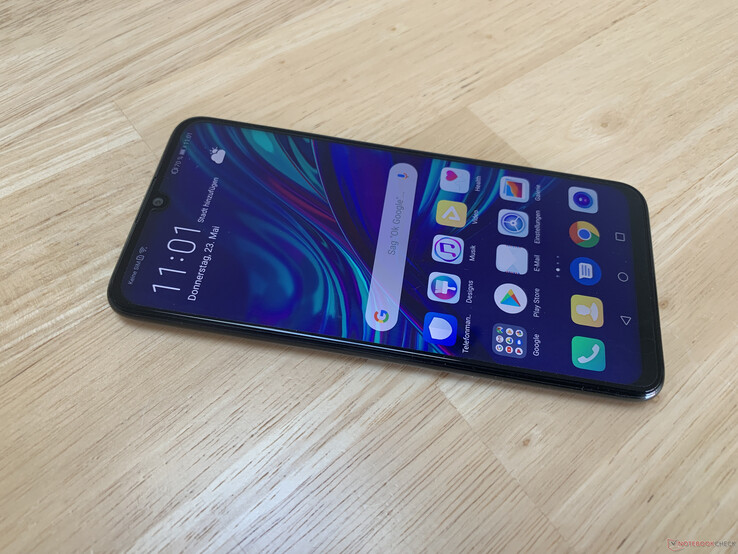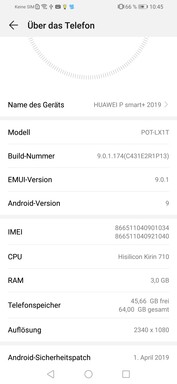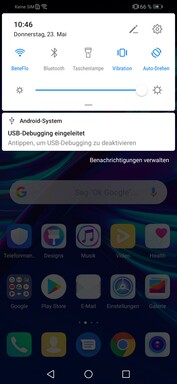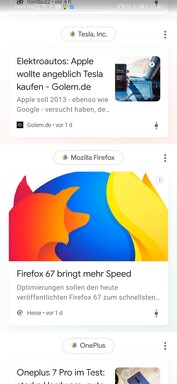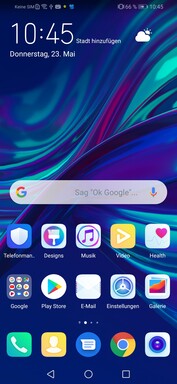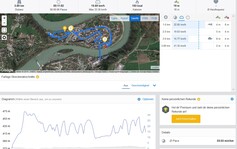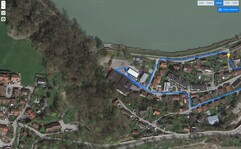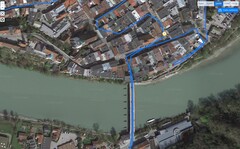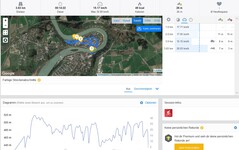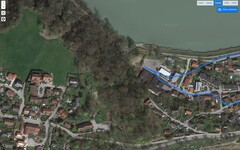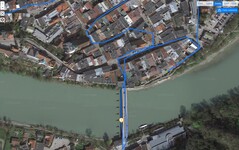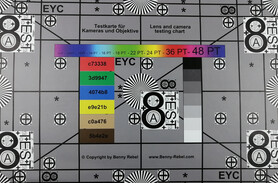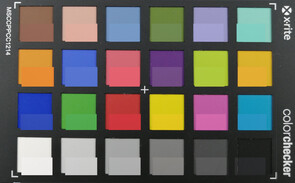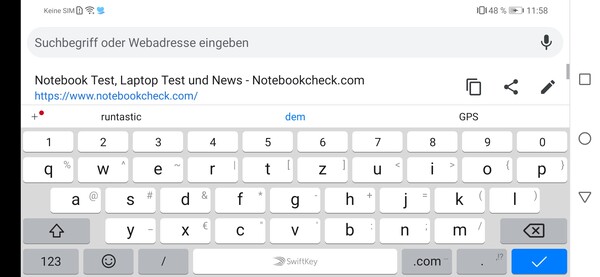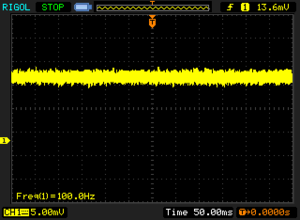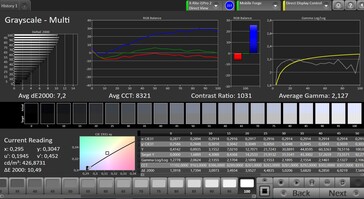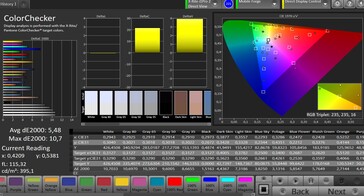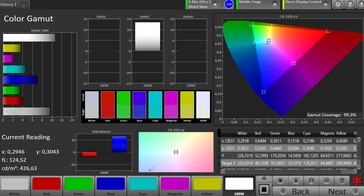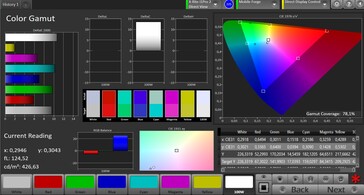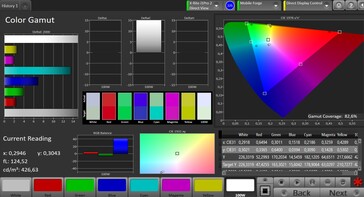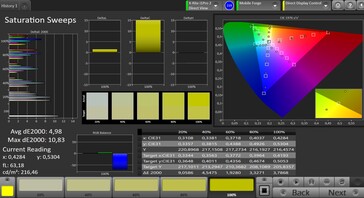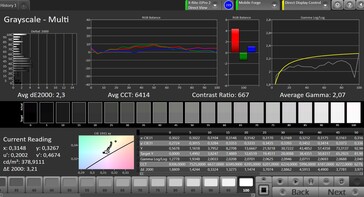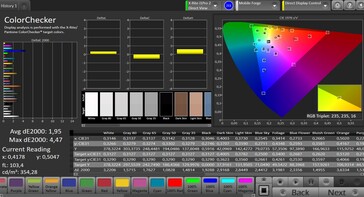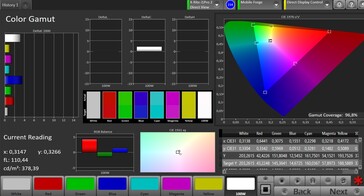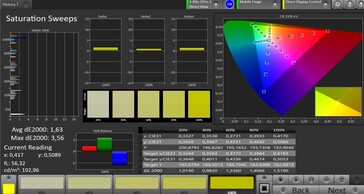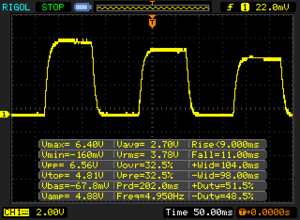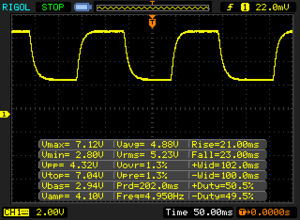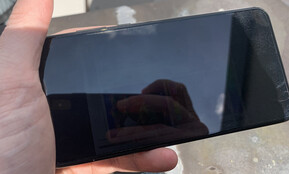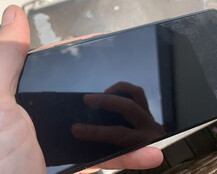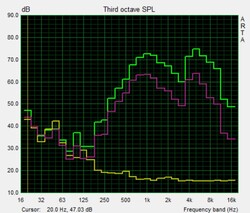Huawei P Smart Plus 2019 Smartphone Review

Last year things were still in order: The differences between the P Smart (2018) and the P Smart+ (2018) were clear and therefore the "Plus" designation was absolutely justified. But now in 2019, things have changed and this year's P Smart+ looks (almost) exactly like the model without the "Plus" designation: It has the same size, offers the same processor, and it costs barely 10 Euros (~$11) more. Are there any differences at all? Yes, of course the two differ from each other in some areas, particularly in the camera and the case colors.
In our test, we compare the P Smart Plus (2019) with the P Smart Plus (2018), the P Smart (2019) and other smartphones of this price range: the Motorola Moto G7, the Honor 10 Lite, and the Samsung Galaxy M20.
Case – Other color variations than for the P Smart (2019)
You can get the Huawei P Smart+ 2019 in Midnight Black and Starlight Blue, which is a slightly different variation of blue than in the Huawei P Smart (2019). Otherwise the case is identical in terms of size, weight, and looks, aside from the third camera module that is offered additionally by the Plus model and is seated separately below the already known dual-camera module.
In terms of differences compared to the P Smart + (2018), you can also immediately identify the third camera module, the smaller waterdrop notch and the slightly lower weight. The display is slightly smaller, and the case is minimally more compact than that from last year.
In terms of both the look and feel, we were already annoyed with the P Smart (2019) by the protective foil for the screen that is obviously glued on, and this is also present in the P Smart Plus 2019. The back continues to be glossy, smooth, and somewhat susceptible to fingerprints.
While the stability is decent, pressure on the back becomes visible in the liquid crystal display of the smartphone. The smartphone can only be warped minimally and there is no creaking in response.
Equipment – Less RAM than last year
With 3 GB of working memory and 64 GB for data storage, the Huawei P Smart Plus (2019) is similarly equipped as the P Smart (2019) but offers 1 GB less RAM than its predecessor. This is annoying, since it would have been a good way to differentiate the smartphone a bit more from its P Smart sibling model.
There continues to be a dual-SIM slot, with one of the slots also being able to fit a microSD card, which would then block one slot. The microSD can only be used for your own data and not for apps, and it also cannot be formatted as internal storage.
There is a microUSB connection and a 3.5-mm audio port at the bottom edge.
Software – Android 9 is installed on the Huawei smartphone
Our test unit is already based on Android 9, and at the time of our test the security patches are from April 1, 2019, so they are quite current. In addition to the in-house Huawei shop, there are also numerous other apps preinstalled. However, they can all be uninstalled if you like, even the third-party advertising apps. While it would of course be better if the smartphone came without these apps, it is positive and not a given that you can uninstall them.
Huawei's own user interface layer above Android is called EMUI. It offers a slightly changed design and several additional functions compared to stock Android. For example, there is a simple mode where you can only access the most important functions using large icons. There is no dark mode, however.
Communication and GPS – Only the most necessary frequencies
In terms of WLAN, our test unit offers similar transfer rates as the P Smart (2019) in our test with the Linksys EA8500 reference router and is thus significantly faster than the Huawei P Smart Plus from last year. When scrolling through websites, images are in parts already preloaded, so that the pages are rendered quickly. Near the router, the full reception is available; at 10-meter distance and through three walls there is still half the signal and pages render slightly slower.
Since only the most necessary 4G frequencies are available, you might have to do without mobile 4G Internet when traveling to far-away countries. In city surroundings, the reception was good in the well-established German D2 net.
Determining our location via GPS is not possible indoors, not even near a window. Outdoors, it takes a moment before sufficient satellites become available to locate us with an accuracy of up to five meters. The location in Google Maps is accurate up to a few meters, and the compass points towards the right-looking direction.
Our practice test, which is a bike tour with the P Smart Plus (2019) and the Garmin Edge 520 on board for comparison, shows slightly wobbly locating abilities in all situations. Our test unit likes to take short cuts or places us next to the road, so it should only be used for simple navigation tasks.
Telephone Functions and Voice Quality – Easily understandable
As telephone app, the known in-house app from Huawei is used. You are greeted by the dial pad and can then select contacts and favorites via tabs.
We like the voice quality. If necessary, the earpiece and the speaker can become quite loud, reproducing the voice of our conversation partner well. At maximum volume, there is some slight booming, but this is not very pronounced. Our voice is also transferred well, whether we speak quietly or with a loud voice.
Cameras – Triple camera with wide angle lens
The camera setup makes up the largest difference between the Huawei P Smart (2019) and the P Smart Plus (2019). On the back of the Plus model, there are three cameras with a higher resolution than in the sibling model. The main camera offers 24 megapixels, and there is an additional wide angle lens with 16 megapixels and another lens with 2 megapixels for calculating the depth sharpness.
By default, the software of the main camera uses a 12-megapixel resolution where two pixels are combined into one, so more information per pixel is available. However, you can also use the full 24-megapixel resolution if you like.
The wide angle lens is a welcome addition to make the camera more flexible. However, unfortunately a smooth zoom is not possible with the camera software and you can merely switch between the main camera and the wide angle lens. In addition, the wide angle lens produces a clear fish-eye effect, so the edges are distorted.
Compared to higher-quality camera modules, the main camera shows little dynamic in dark areas, and for nearby objects the image sharpness is also not ideal. In pictures of the surroundings, the color reproduction is not bad, and far away objects are also depicted with a good detail level. In weak light conditions, the P Smart Plus (2019) is at the level of its price range but is unable to keep up with more-expensive camera modules in terms of sharpness and level of detail.
Videos can be recorded at a maximum of 1080p and 30 fps, and other camera apps also offer no improvement here. You can also use the standard or the wide angle lens, and you can even switch during the recording. The recorded videos offer a decent detail and color reproduction, but the aperture reacts to changes in brightness in a slightly delayed manner and also with visible steps. In addition, the compression of videos is apparently fairly strong, since you can see pixelation in the light transitions.
The front camera corresponds to the camera in the Huawei P Smart (2019) with 8 megapixels. It is also slightly grainy here and offers little detail. However, colors are reproduced fairly well, so the quality should be sufficient for the occasional selfie.
In our tests in the lab under controlled light conditions, the main camera of the Huawei P Smart Plus (2019) noticeably shows frayed edges in the details, and the contrast is also too low, which can be seen in the black writing on a dark background that you can hardly distinguish.
The color reproduction is okay overall, but the color areas are often not reproduced cleanly but with pixelation.
Accessories and Warranty – A good amount of accessories
In addition to the charger and the USB cable, a silicon bumper case and a headset are also included. There is also a SIM tool to open the tray. There are no specific accessories for this smartphone on Huawei's website at the moment.
The manufacturer offers a 24-month warranty for its smartphones.
Input Devices and Navigation – A smooth touchscreen in the P Smart Plus (2019)
The touchscreen with the fixed protective film is easy to use and hardly offers any resistance to the finger. As the keyboard app, SwiftKey is used, and the keyboard can be adjusted extensively. You can also install other input methods without any trouble.
There is a fingerprint sensor on the back that responds very quickly and reliably. For face recognition, Huawei's Face Scan is used, which unlocks the smartphone fairly reliably in our test, but this only works in light surroundings. In addition, this method is not as secure as a fingerprint sensor or face recognition based on additional hardware.
Display – Similar to the sibling model
The display corresponds to that in the Huawei P Smart (2019) and only differs in some details in the measurements. The overall deviation of 8% is just barely within the customary range of a series. Overall, the display is at the same level as those of other smartphones of this price range. We particularly like the low black value.
| |||||||||||||||||||||||||
Brightness Distribution: 84 %
Center on Battery: 427 cd/m²
Contrast: 2135:1 (Black: 0.2 cd/m²)
ΔE ColorChecker Calman: 1.95 | ∀{0.5-29.43 Ø4.78}
ΔE Greyscale Calman: 2.3 | ∀{0.09-98 Ø5}
96.8% sRGB (Calman 2D)
Gamma: 2.07
CCT: 6414 K
| Huawei P Smart Plus 2019 IPS, 2340x1080, 6.2" | Huawei P Smart 2019 IPS, 2340x1080, 6.2" | Huawei P Smart Plus IPS/LTPS, 2340x1080, 6.3" | Motorola Moto G7 IPS, 2270x1080, 6.2" | Honor 10 Lite IPS, 2340x1080, 6.2" | Samsung Galaxy M20 PLS TFT, 2340x1080, 6.3" | |
|---|---|---|---|---|---|---|
| Screen | -8% | -73% | -69% | -27% | -76% | |
| Brightness middle (cd/m²) | 427 | 458 7% | 479 12% | 471 10% | 467 9% | 452 6% |
| Brightness (cd/m²) | 415 | 440 6% | 471 13% | 453 9% | 446 7% | 445 7% |
| Brightness Distribution (%) | 84 | 85 1% | 94 12% | 94 12% | 89 6% | 92 10% |
| Black Level * (cd/m²) | 0.2 | 0.35 -75% | 0.27 -35% | 0.5 -150% | 0.58 -190% | 0.41 -105% |
| Contrast (:1) | 2135 | 1309 -39% | 1774 -17% | 942 -56% | 805 -62% | 1102 -48% |
| Colorchecker dE 2000 * | 1.95 | 1.4 28% | 6.24 -220% | 5.5 -182% | 1.5 23% | 5.3 -172% |
| Colorchecker dE 2000 max. * | 4.47 | 3.8 15% | 10.05 -125% | 7.95 -78% | 4.5 -1% | 9.5 -113% |
| Greyscale dE 2000 * | 2.3 | 2.4 -4% | 7.4 -222% | 5 -117% | 2.4 -4% | 6.8 -196% |
| Gamma | 2.07 106% | 2.22 99% | 2.39 92% | 2.326 95% | 2.22 99% | 2.23 99% |
| CCT | 6414 101% | 6235 104% | 8942 73% | 7654 85% | 6387 102% | 8355 78% |
* ... smaller is better
Screen Flickering / PWM (Pulse-Width Modulation)
| Screen flickering / PWM detected | 100 Hz | ≤ 10 % brightness setting | |
The display backlight flickers at 100 Hz (worst case, e.g., utilizing PWM) Flickering detected at a brightness setting of 10 % and below. There should be no flickering or PWM above this brightness setting. The frequency of 100 Hz is very low, so the flickering may cause eyestrain and headaches after extended use. In comparison: 53 % of all tested devices do not use PWM to dim the display. If PWM was detected, an average of 8111 (minimum: 5 - maximum: 343500) Hz was measured. | |||
In the lab, we measure PWM flickering at very low brightness values. On the other hand, the response times in our test are minimally faster than those of the sibling model.
There are two presets for the image display: Vivid and Normal. With the Vivid setting, we measure a clear blue tint that almost completely disappears in the Normal setting. Also, the colors are reproduced very accurately in the Normal setting, while there are more deviations in the Vivid setting. At the same time, the colors then also appear more vivid, as the name already indicates.
Display Response Times
| ↔ Response Time Black to White | ||
|---|---|---|
| 20 ms ... rise ↗ and fall ↘ combined | ↗ 9 ms rise | |
| ↘ 11 ms fall | ||
| The screen shows good response rates in our tests, but may be too slow for competitive gamers. In comparison, all tested devices range from 0.1 (minimum) to 240 (maximum) ms. » 42 % of all devices are better. This means that the measured response time is similar to the average of all tested devices (20.2 ms). | ||
| ↔ Response Time 50% Grey to 80% Grey | ||
| 44 ms ... rise ↗ and fall ↘ combined | ↗ 21 ms rise | |
| ↘ 23 ms fall | ||
| The screen shows slow response rates in our tests and will be unsatisfactory for gamers. In comparison, all tested devices range from 0.165 (minimum) to 636 (maximum) ms. » 72 % of all devices are better. This means that the measured response time is worse than the average of all tested devices (31.6 ms). | ||
Outdoors, the Huawei P Smart Plus (2019) does fairly well, but in direct sunlight you can hardly see anything on the display anymore. The brightness sensor is fairly reliable in choosing the correct brightness setting.
We have no complaints about the viewing angles, and the colors are also reproduced well from very steep viewing angles.
Performance – Midrange performance is available
As in the Huawei P Smart (2019), the Kirin 710, which is an SoC from Huawei's own production, is also used in the Huawei P Smart Plus (2019). It has a total of eight processor cores, four with a maximum 2.2 GHz and four with a maximum 1.7 GHz clock speed. Accordingly, the performance is at the same level as that of the sibling model. However, due to its smaller working memory, the Huawei P Smart Plus (2019) achieves less points than the P Smart Plus (2018), which uses the same SoC.
Overall, the processor performance is at the level of the price class, and we rarely notice any stutters during operation.
As the graphics solution, the Mali-G51 MP4 is used, and there are definitely some midrange graphics cards that offer less performance. So the Huawei P Smart Plus (2019) does well here in comparison.
In general, the browser performance is good in the Huawei P Smart Plus (2019). Pages are rendered quickly, and in the benchmarks the smartphone places in the middle or towards the top of the comparison field.
More-demanding HTML-5 pages are also loaded quickly and displayed fairly smoothly.
| Jetstream 2 - 2.0 Total Score | |
| Average of class Smartphone (23.8 - 387, n=154, last 2 years) | |
| Average HiSilicon Kirin 710 (30 - 33, n=8) | |
| Huawei P Smart Plus 2019 (Chrome 74) | |
| Samsung Galaxy M20 (Samsung Brwoser 9.2) | |
| Speedometer 2.0 - Result 2.0 | |
| Average of class Smartphone (15.2 - 643, n=128, last 2 years) | |
| Average HiSilicon Kirin 710 (30.4 - 33.9, n=6) | |
| Huawei P Smart Plus 2019 (Chome 74) | |
| Samsung Galaxy M20 | |
| WebXPRT 3 - Overall | |
| Average of class Smartphone (38 - 380, n=35, last 2 years) | |
| Huawei P Smart 2019 (Chrome 70) | |
| Huawei P Smart Plus 2019 (Chrome 74) | |
| Honor 10 Lite (Chrome 71) | |
| Average HiSilicon Kirin 710 (52 - 69, n=11) | |
| Huawei P Smart Plus (Chrome 71) | |
| Motorola Moto G7 (Chrome 71) | |
| Samsung Galaxy M20 | |
| Octane V2 - Total Score | |
| Average of class Smartphone (2228 - 121337, n=201, last 2 years) | |
| Huawei P Smart 2019 (Chrome 70) | |
| Huawei P Smart Plus 2019 (Chrome 74) | |
| Average HiSilicon Kirin 710 (9041 - 10544, n=13) | |
| Honor 10 Lite (Chrome 71) | |
| Huawei P Smart Plus (Chrome 71) | |
| Samsung Galaxy M20 | |
| Motorola Moto G7 (Chrome 71) | |
| Mozilla Kraken 1.1 - Total | |
| Motorola Moto G7 (Chrome 71) | |
| Huawei P Smart Plus (Chrome 71) | |
| Huawei P Smart Plus 2019 (Chrome 74) | |
| Average HiSilicon Kirin 710 (3999 - 4853, n=13) | |
| Honor 10 Lite (Chrome 71) | |
| Huawei P Smart 2019 (Chrome 70) | |
| Samsung Galaxy M20 | |
| Average of class Smartphone (257 - 28190, n=156, last 2 years) | |
* ... smaller is better
In terms of storage speed, there are hardly any differences to the Huawei P Smart (2019), and the eMMC storage is slightly faster than those in many comparison devices.
With our Toshiba Exceria Pro M501 reference storage card, the Huawei smartphone also achieves decent read and write rates.
| Huawei P Smart Plus 2019 | Huawei P Smart 2019 | Huawei P Smart Plus | Motorola Moto G7 | Honor 10 Lite | Samsung Galaxy M20 | Average 64 GB eMMC Flash | Average of class Smartphone | |
|---|---|---|---|---|---|---|---|---|
| AndroBench 3-5 | 5% | 27% | 21% | 3% | 2% | -1% | 680% | |
| Sequential Read 256KB (MB/s) | 295.4 | 288.3 -2% | 303.2 3% | 297 1% | 288.5 -2% | 300 2% | 277 ? -6% | 2223 ? 653% |
| Sequential Write 256KB (MB/s) | 152.8 | 191.4 25% | 200.5 31% | 216 41% | 190.6 25% | 137 -10% | 178.4 ? 17% | 1838 ? 1103% |
| Random Read 4KB (MB/s) | 40.3 | 45.66 13% | 102.5 154% | 69.3 72% | 45.15 12% | 64 59% | 60.7 ? 51% | 295 ? 632% |
| Random Write 4KB (MB/s) | 77.3 | 70.7 -9% | 74 -4% | 75.6 -2% | 66.1 -14% | 44 -43% | 33.8 ? -56% | 335 ? 333% |
| Sequential Read 256KB SDCard (MB/s) | 76.3 ? | 76.2 ? 0% | 76.9 ? 1% | 86.9 ? 14% | 75.8 ? -1% | 81.5 ? 7% | 77.4 ? 1% | |
| Sequential Write 256KB SDCard (MB/s) | 66.7 ? | 66.9 ? 0% | 51.9 ? -22% | 66.8 ? 0% | 67 ? 0% | 65.3 ? -2% | 58.3 ? -13% |
Games – Gaming possible
Basically you can play games fairly well with the Huawei P Smart Plus (2019). The touchscreen with its smooth surface is responsive and the position sensor is also reliable.
Using the GameBench app, we evaluate the frame rates in several popular games. In Asphalt 9, some sudden frame-rate fluctuations become apparent at high quality settings during the latter part of our run. However, subjectively we did not notice them; perhaps they were just too short to see. On the other hand, Arena of Valor runs smoothly at 30 fps in all quality settings.
Emissions – The P Smart Plus (2019) throttles
Temperature
In the temperature test, the Huawei P Smart Plus (2019) becomes significantly warmer than its sibling model. Up to 42.5 °C (108.5 °F) can become uncomfortable particularly during the summer, especially if you put the device in your pocket after longer load. On the other hand, there is hardly any noticeable warming during idle operation.
Unfortunately there is also a clearly noticeable performance drop after a longer period of load. During the 29th run of GFXBench Manhattan 3.1, the frame rate of our test unit drops by more than 25% compared to the first run. This can be tested easily with the battery test of GFXBench.
(±) The maximum temperature on the upper side is 42.5 °C / 109 F, compared to the average of 35.2 °C / 95 F, ranging from 21.9 to 247 °C for the class Smartphone.
(±) The bottom heats up to a maximum of 41 °C / 106 F, compared to the average of 34 °C / 93 F
(+) In idle usage, the average temperature for the upper side is 30.6 °C / 87 F, compared to the device average of 32.9 °C / 91 F.
Speaker
As in the P Smart (2019), the mono speaker is positioned on the bottom edge. It is slightly louder than that in the predecessor and offers slightly stronger and emphasized mids, producing a warmer sound. The sound is slightly more balanced overall than in the Huawei P Smart (2019).
For audiophile listeners it would still be more satisfying to connect headphones or speakers using the 3.5-mm port or Bluetooth. Although Bluetooth 5.0 is not included yet, the connection works very fast via cable as well as wireless, and the sound is transmitted cleanly.
Huawei P Smart Plus 2019 audio analysis
(±) | speaker loudness is average but good (81.8 dB)
Bass 100 - 315 Hz
(-) | nearly no bass - on average 66% lower than median
(+) | bass is linear (0% delta to prev. frequency)
Mids 400 - 2000 Hz
(-) | nearly no mids - on average 66% lower than median
(+) | mids are linear (0% delta to prev. frequency)
Highs 2 - 16 kHz
(-) | nearly no highs - on average 66% lower than median
(+) | highs are linear (0% delta to prev. frequency)
Overall 100 - 16.000 Hz
(-) | overall sound is not linear (121.3% difference to median)
Compared to same class
» 90% of all tested devices in this class were better, 8% similar, 2% worse
» The best had a delta of 11%, average was 35%, worst was 134%
Compared to all devices tested
» 97% of all tested devices were better, 2% similar, 1% worse
» The best had a delta of 4%, average was 24%, worst was 134%
Huawei P Smart Plus audio analysis
(±) | speaker loudness is average but good (79.2 dB)
Bass 100 - 315 Hz
(-) | nearly no bass - on average 22.7% lower than median
(±) | linearity of bass is average (9.9% delta to prev. frequency)
Mids 400 - 2000 Hz
(+) | balanced mids - only 2.9% away from median
(+) | mids are linear (4.3% delta to prev. frequency)
Highs 2 - 16 kHz
(±) | higher highs - on average 8.2% higher than median
(+) | highs are linear (5.7% delta to prev. frequency)
Overall 100 - 16.000 Hz
(±) | linearity of overall sound is average (23.2% difference to median)
Compared to same class
» 52% of all tested devices in this class were better, 7% similar, 41% worse
» The best had a delta of 11%, average was 35%, worst was 134%
Compared to all devices tested
» 69% of all tested devices were better, 5% similar, 26% worse
» The best had a delta of 4%, average was 24%, worst was 134%
Battery Life – Room for expansion
Power Consumption
The power consumption overall is at a very similar level as that of the Huawei P Smart (2019). Only in the average idle scenario is the P Smart Plus slightly more efficient in our test. Overall as well, the P Smart Plus (2019) is a fairly low-consumption smartphone in its class.
| Off / Standby | |
| Idle | |
| Load |
|
Key:
min: | |
| Huawei P Smart Plus 2019 3400 mAh | Huawei P Smart 2019 3400 mAh | Huawei P Smart Plus 3340 mAh | Motorola Moto G7 3000 mAh | Honor 10 Lite 3400 mAh | Samsung Galaxy M20 5000 mAh | Average HiSilicon Kirin 710 | Average of class Smartphone | |
|---|---|---|---|---|---|---|---|---|
| Power Consumption | -17% | -47% | -17% | -22% | -15% | -27% | -21% | |
| Idle Minimum * (Watt) | 0.8 | 0.84 -5% | 1.3 -63% | 1.1 -38% | 1 -25% | 0.94 -18% | 1.058 ? -32% | 0.848 ? -6% |
| Idle Average * (Watt) | 1.2 | 2.21 -84% | 2.5 -108% | 1.8 -50% | 2.19 -83% | 2.37 -98% | 2.2 ? -83% | 1.434 ? -20% |
| Idle Maximum * (Watt) | 2.3 | 2.23 3% | 3.6 -57% | 2.6 -13% | 2.2 4% | 2.42 -5% | 2.57 ? -12% | 1.618 ? 30% |
| Load Average * (Watt) | 4.5 | 4.2 7% | 5 -11% | 4.2 7% | 4.64 -3% | 3.83 15% | 4.61 ? -2% | 7.01 ? -56% |
| Load Maximum * (Watt) | 7.3 | 7.86 -8% | 7 4% | 6.8 7% | 7.7 -5% | 5.07 31% | 7.6 ? -4% | 11.3 ? -55% |
* ... smaller is better
Battery Life
In terms of the battery life, not much has changed, neither since the previous generation nor compared to the P Smart (2019). It continues to be about 8:43 hours in the WLAN test, which is a rather mediocre value that for example the Motorola Moto G7 or the Samsung Galaxy M20 can exceed significantly.
With this, you can get safely through at least a day at the office, and those who are more economic with usage might even be able to manage two days without a charge. Huawei includes a quick charger that completely recharges the device within 1.5 to 2 hours.
| Huawei P Smart Plus 2019 3400 mAh | Huawei P Smart 2019 3400 mAh | Huawei P Smart Plus 3340 mAh | Motorola Moto G7 3000 mAh | Honor 10 Lite 3400 mAh | Samsung Galaxy M20 5000 mAh | |
|---|---|---|---|---|---|---|
| Battery runtime | -5% | -2% | 28% | -7% | 61% | |
| Reader / Idle (h) | 22.4 | 21.6 -4% | 25.8 15% | 25.6 14% | 31.7 42% | |
| H.264 (h) | 8.9 | 7.7 -13% | 13.7 54% | 8.4 -6% | 18.7 110% | |
| WiFi v1.3 (h) | 8.7 | 8.4 -3% | 8.5 -2% | 13.3 53% | 8.1 -7% | 15.5 78% |
| Load (h) | 4.2 | 4.3 2% | 3.7 -12% | 3 -29% | 4.8 14% |
Pros
Cons
Verdict – For the small surcharge it is the better choice
The point of Huawei's model policy this year is not quite clear: Why does the manufacturer bring two devices to market that besides the camera only differ in details and also have almost the same price? The Huawei P Smart Plus (2019) is not a bad smartphone at all and with its faster WLAN and triple camera system it also shows some improvements compared to its predecessor.
On the other hand, the GPS could have been more accurate and the scratch and fingerprint prone back is not optimal either. All the devices of this series also have some catching up to do in terms of their battery life, even though the power consumption is not very high. So it is probably the power management that leaves some room for improvement.
The Huawei P Smart Plus (2019) is a midrange smartphone with a triple camera system that hardly differs from its sibling model.
So which should you choose - the Huawei P Smart Plus (2019) or the Huawei P Smart (2019)? In terms of the price, the difference is almost negligible. Because of this and the many similarities and better camera, we would want to get the Plus model.
However, there are also some good alternatives this year. You can get more battery life with the Motorola Moto G7 or the Samsung Galaxy M20. With last year's Huawei P Smart you can even save a few additional Euros and get more working memory, but then you also have to make do with a camera that is less flexible.
Huawei P Smart Plus 2019
- 05/23/2019 v6 (old)
Florian Schmitt




